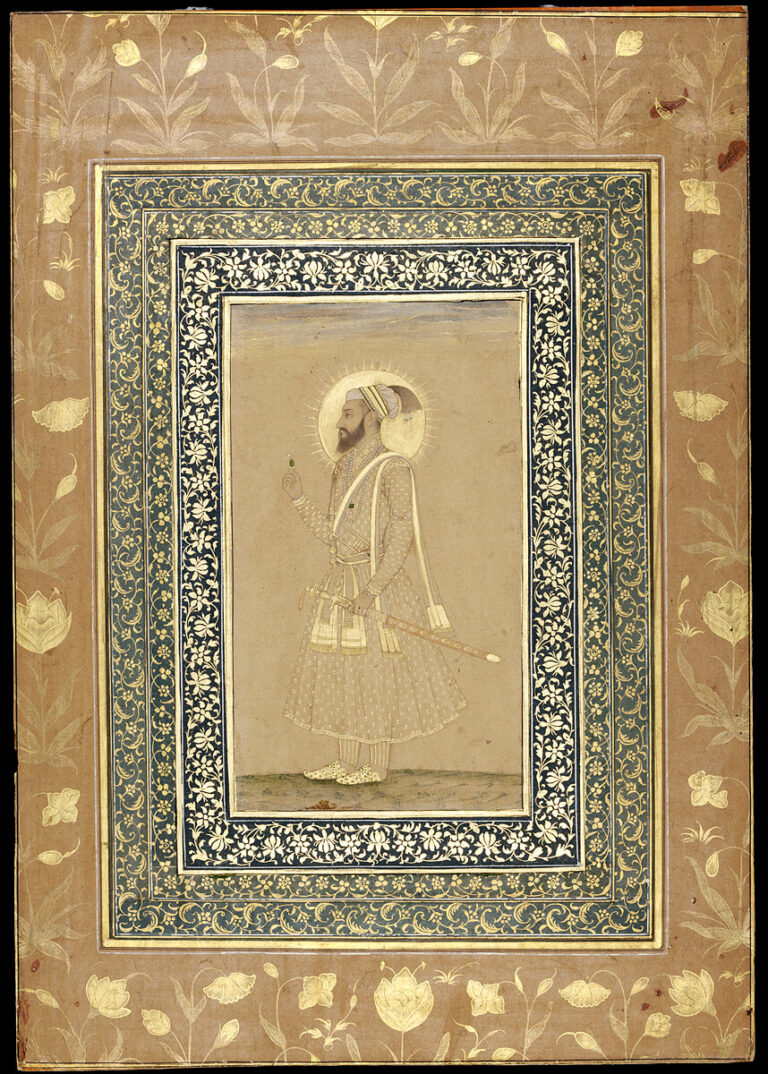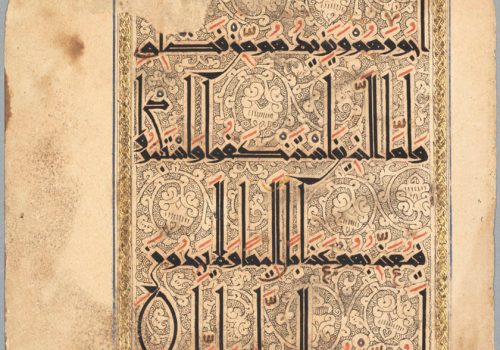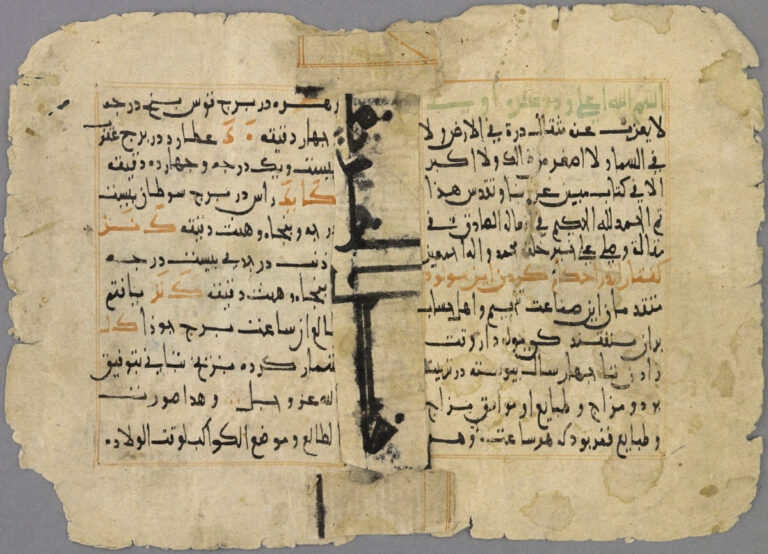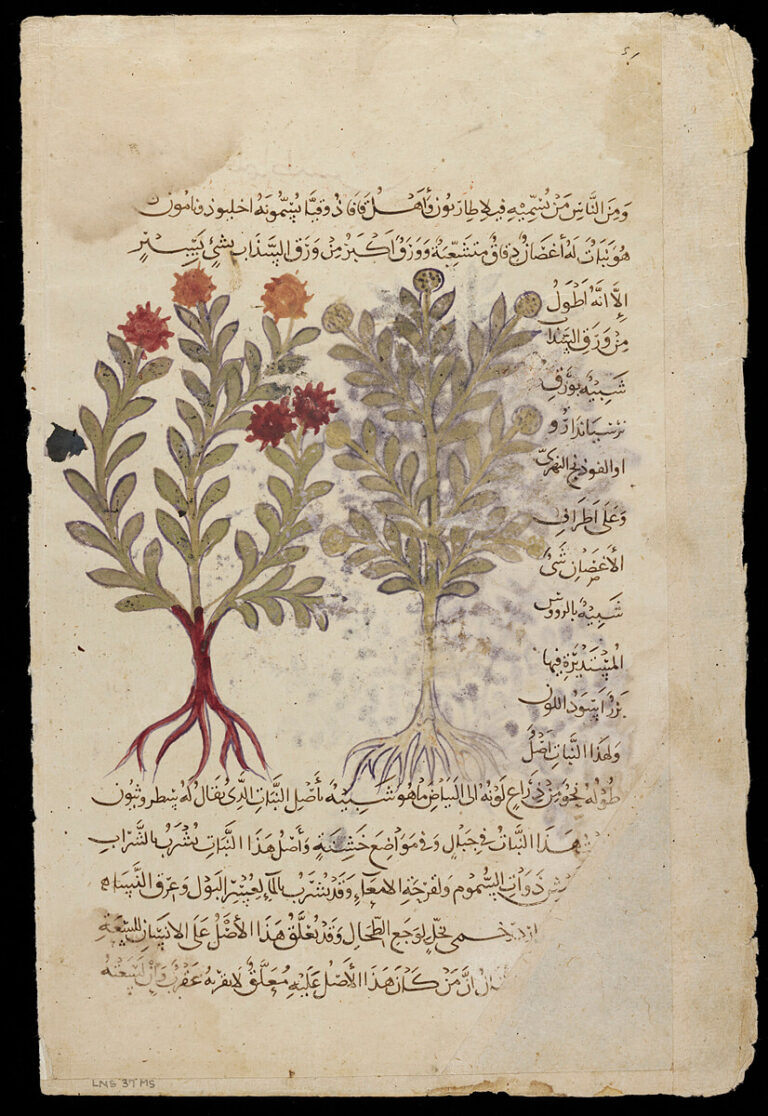Inv. no. LNS 37 MS, verso
Ink and colors on paper
Height 29.6 cm; width 20 cm
Iraq, 13th century AD
7th century AH
Art Of the Book
The al-Sabah Collection is rich in manuscripts of the Qur’an. These range from a double page folio from one of the earliest known manuscripts, copied in the second century of Islam in a distinctive vertical script known as Hijazi, to a superbly decorated, large format manuscript signed by a famous calligrapher from Shiraz, while working at the royal court of Golconda in the Deccan in the 16th century CE.
An enormous number of Islamic manuscripts survive though relatively few are illustrated, particularly when it comes to works of Arabic literature. By contrast, a large number of illustrated manuscripts of Persian poetry were produced, some of the most important and beautiful examples of Islamic book arts.
Miniature paintings and calligraphic exercises were included in albums prepared for royal patrons. The schools of painting inherited by Mughal India and the Deccan were profoundly changed by exposure to Persian painting, but developed in different directions, retaining an interest in realistic depictions of the natural world.

LNS 37 MS
Folio from a manuscript of Pedanius Dioscorides’ De materia medica...

LNS 57 MS
Folio from an album depicting a sumptuously dressed painter at...

LNS 57 MS
Folio from an album depicting a sumptuously dressed painter at work on a miniature in the contemporary style of Iran or the Deccan; probably by the Mughal painter Manohar (‘signed and dated’ at bottom left ‘Work of Bihzad 894’ [= 1488-89], indicating that it is a ‘copy’ of an original by the famous late Timurid painter Bihzad)
Inv. no. LNS 57 MS
Height 33 cm; width 27.3 cm
Ink, colors and gold on paper
North India, ca. 1st decade 17th century AD
ca. 1st decade 11th century AH
You can share this object via:

LNS 77 MS
Miniature painting on silk depicting a princely couple in the...

LNS 77 MS
Miniature painting on silk depicting a princely couple in the company of attendants, variously bejeweled and opulently dressed in gold-decorated and fur-lined very long-sleeved cloaks
Inv. no. LNS 77 MS
Height 20 cm; width 28.3 cm
Colors and gold on silk
Probably Central Asia, early 15th century AD
early 9th century AH
You can share this object via:

LNS 345 MS
Folio from an album with the portrayal of a lavishly-dressed...

LNS 345 MS
Folio from an album with the portrayal of a lavishly-dressed youth drinking wine, with floral and foliate border in gold; the reverse an illuminated calligraphic page which includes love poems (ghazals) by Hafiz and couplets from the Bustan of Sa‘di, as well as additional unidentified verses
Inv. no. LNS 345 MS
Height 34 cm; width 20 cm
Ink, colours and gold on paper
Iran, Isfahan, ca. 1600 AD
ca. 1008 – 1009 AH
You can share this object via:

LNS 112 MS
Folio from an album portraying the Mughal emperor ‘Alamgir (Awrangzeb,...

LNS 112 MS
Folio from an album portraying the Mughal emperor ‘Alamgir (Awrangzeb, son of Shah Jahan) holding a hexagonal emerald and wearing a rectangular one, as well as fine pearls; the reverse with a calligraphic composition rendering Persian verses, signed by the calligrapher ‘Abd Allah al-Husayny
Inv. no. LNS 112 MS
Ink, colors and gold on paper
Height 18.3 cm; width 10.4 cm
India, ca. 1658-70 AD
ca. 1069-81 AH
You can share this object via:

LNS 17 MS f 123v
Folio from The Book of Knowledge of Ingenious Mechanical Devices...

LNS 17 MS f 123v
Folio from The Book of Knowledge of Ingenious Mechanical Devices by Isma‘il ibn ar-Razzaz al-Jazari, illustrating the water-powered mechanism for a ‘perpetual flute’, the text in elegant naskhi script; signed by the calligrapher Farrukh ibn ‘Abd al-Latif
Inv. no. LNS 17 MS f 123v
Ink, colours and gold on paper
Height 31.2 cm; width 21.5 cm
Probably Syria or India [more likely Iraq], dated Ramadan 715 AH/December 1315 AD
You can share this object via:

LNS 63 MS a
Folio from a sumptuous and famous manuscript of the Qur’an,...

LNS 63 MS a
Folio from a sumptuous and famous manuscript of the Qur’an, all the text of which is executed in ‘eastern Kufic’ against an elaborately decorated ground of palmettes framed by scrolling stems (chapter 4, verses 173-75)
Inv. no. LNS 63 MS a
Ink, colours and gold on paper
Height 46.3 cm; width 34 cm
East Iranian world, 11th century AD
5th century AH
You can share this object via:

LNS 297 MS
Illustrated folio depicting the capture of Marzuq’s and the Frank’s...

LNS 297 MS
Illustrated folio depicting the capture of Marzuq’s and the Frank’s (Europeans) fortress by the Amir Hamza, from a manuscript of an epic narrating the exploits of Amir Hamza (understood as the uncle of the prophet Muhammad), known as the Dastan-e Amir Hamza or Hamza-nameh (Tales of Amir Hamza). The colossal manuscript was commissioned by the Mughal emperor Akbar in a series of approximately fourteen volumes
Inv. no. LNS 297 MS
Ink, colours and gold on cotton fabric
Height 69.2 cm; width 57.8 cm
India, 3rd quarter, 16th century AD
3rd quarter 10th century AH
You can share this object via:

LNS 286 MS
Illustrated leaf from a manuscript of the Universal History (Jami‘...

LNS 286 MS
Illustrated leaf from a manuscript of the Universal History (Jami‘ at-Tawarikh), written by the Ilkhanid vizier Rashid ad-Din and augmented at the Mughal court under the Emperor Akbar; layout and painting by the artist Tulsi, depicting the bier of the Ilkhanid Mongol ruler Hülegü Khan
Inv. no. LNS 286 MS
Ink, colours and gold on paper
Height 35.7 cm; width 23 cm
North India, ca. 1600 AD
ca. 1009 AH
You can share this object via:

LNS 274 MS
Illustrated leaf from a manuscript of the Khamsa or series...

LNS 274 MS
Illustrated leaf from a manuscript of the Khamsa or series of epic poems of Nizami, depicting the Mi‘raj, or transport of the Prophet Muhammad to Jerusalem, on the mount Buraq
Inv. no. LNS 274 MS
Ink, colour and gold on paper
Height 22.4 cm; width 14.4 cm
Iranian world, ca. 16th century AD
ca. 10th century AH
You can share this object via:

LNS 66 MS, f. 22 v.
Illustrated genealogy of the Ottoman sultans, traced through various dynasties...

LNS 66 MS, f. 22 v.
Illustrated genealogy of the Ottoman sultans, traced through various dynasties and the Prophets back to Adam, this page depicting the Ottoman sultans Orkhan, Murad and Yildirim Bayazid
Inv. no. LNS 66 MS, f. 22 v.
Ink, colours and gold on paper; binding leather, dyed, stamped, tooled and partially gold-leafed
Height 24.3 cm; width of folio 16.2 cm
Ottoman Empire, ca. late 16th – early 17th century AD (with other sections and binding of later date)
ca. late 10th – early 11th century AD
You can share this object via:

LNS 8 MS
Illuminated manuscript of the Qur’an, the text in clouds on...

LNS 275 MS
Paper folios from the astrological birth chart of a newborn,...

LNS 275 MS
Paper folios from the astrological birth chart of a newborn, giving the coordinates of the planets and lunar nodes at the time of birth. The single folio contains predictions for the future of the newborn.
Inv. no. LNS 275 MS a
Ink, colour and gold
(a) Height 15.5 cm; width 22 cm
(b) Height 13.7 cm; width 11.3 cm
East Iranian world, late 12th – early 13th century AD
late 6th – early 7th century AH
You can share this object via:

LNS 2 CA
Parchment folio from a manuscript of the Qur’an in Kufic...

LNS 2 CA
Parchment folio from a manuscript of the Qur’an in Kufic script (Chapter 23: includes the very end of verse 49 to the very beginning of verse 52)
Inv. no. LNS 2 CA a
Ink, colours and gold
Height 19.7 cm; width 31 cm
Probably Qayrawan, Tunisia, 9th century AD
3rd century AH
You can share this object via:

LNS 203 MS
Single folio from a dispersed manuscript of the Qur’an containing...

LNS 203 MS
Single folio from a dispersed manuscript of the Qur’an containing Surat al-Nisa’ from the middle of verse 171 to the beginning of verse 173 written in gold Kufic outlined with brown and with a large illuminated medallion inscribed with the verse count in the margin. The diacritics are indicated with diagonal strokes, the hamza (a letter indicating a glottal stop) in the form of green dots, and vocalization is marked with red and blue dots.
Al Fann Milan October 2010
Parchment folio from a manuscript of the Qur’an in Kufic script (Chapter 4: verses 170-3)
Inv. no. LNS 203 MS
Height 14.5 cm; width 21 cm
Ink, colours and gold
Eastern world 10th century AD
You can share this object via:

